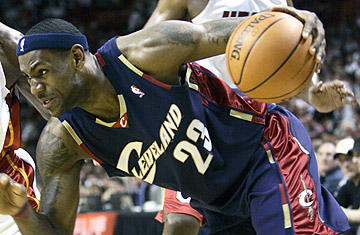
Cleveland Cavaliers' LeBron James (23) drives to the basket in a game against the Miami Heat, February 1, 2007.
Much more than a gimmick designed to trick the eye into believing objects are being hurled at it, NBA 3D HD is meant to create the depth and clarity of picture to produce the sensation of being in the arena. "We're not just going to run after you and freak you out," says NBA Vice President of Engineering Michael Rokosa. "Although there could be instances where a ball comes straight back at the camera, and it's going to feel like it's coming at you."
The broadcast is made possible by PACE, a digital 3D company that, in collaboration with film director James Cameron, has developed a camera with two lenses capable of shooting live footage in three-dimensions, as opposed to traditional methods that require the illusion to be created in post-production. Cameron is planning to use the same cameras in his upcoming film Avatar. At the All-Star game, five will be scattered throughout the arena to catch the action.
Though the technology is at least a few years away from being ready for prime time, the NBA thinks it can be a major boon to sports broadcasting. Provided the experiment in Las Vegas is successful, the league believes the next logical step is to create a medium for fans to gather in public places while their team is playing high-stakes away games. While they hope to set up projectors and screens in arenas — where many fans already flock to watch games on the jumbotron — another practical application would be in movie theaters, some of which are already equipped with digital projectors and satellite dishes.
Last month critics were given a sneak-peek of the technology, which was used to tape a 2006 game between the Los Angeles Lakers and the Phoenix Suns, during which Kobe Bryant sank two buzzer-beaters--one to tie the game and send it into overtime, and another to win it. Only two of PACE's cameras were used, but the crisp clarity of the court, players, and even the crowd were impressive.
Still, problems arose in the layering of foreground and background, which at times was dizzying, and the fact that the ball's rapid movements prevented it from ever coming into focus. And there are other hurdles to overcome; the technology requires twice the normal bandwidth of a regular HD broadcast, which satellite and cable carriers aren't likely to offer until there is enough content (now there isn't any), and the NBA will need to plow a lot of money into development if it wants to expand the technology's reach.
PACE CEO Vincent Pace says the dizzying effects and blurring "artifacts" are problems that have already been improved. The blurring, for example, is a result of compressing the massive amounts of data to fit onto the tape. The broadcast in Las Vegas, on the other hand, will not be > compressed. Solving the vertigo, he says, is simply a matter of having enough cameras and being able to practice making depth corrections. "We're learning the language," he says. "I guarantee you we'll learn something from this event. Anyone who says they> 've got the formula to make it work perfectly is short-changing you."
Pace thinks there is no reason 3D HD should be limited to basketball, and he says all sports are potential candidates. But first the NBA has to convince teams and team owners that this is a technology worth pursuing — and investing in. The league will have its chance this weekend as owners flock to the All-Star game, the NBA's equivalent to an annual convention. Says Rokosa: "You know the saying a picture is worth a thousand words? This one is worth two-thousand."
